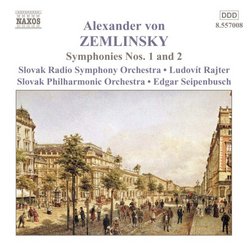| All Artists: Alexander von Zemlinsky, Edgar Seipenbusch, Ludovit Rajter, Slovak Philharmonic Orchestra, Slovak Radio Symphony Orchestra (Bratislava), Slovak Radio Symphony Orchestra Bratislava Title: Alexander von Zemlinsky: Symphonies Nos. 1 & 2 Members Wishing: 0 Total Copies: 0 Label: Naxos Release Date: 3/18/2003 Genre: Classical Style: Symphonies Number of Discs: 1 SwapaCD Credits: 1 UPC: 747313200825 |
Search - Alexander von Zemlinsky, Edgar Seipenbusch, Ludovit Rajter :: Alexander von Zemlinsky: Symphonies Nos. 1 & 2
 | Alexander von Zemlinsky, Edgar Seipenbusch, Ludovit Rajter Alexander von Zemlinsky: Symphonies Nos. 1 & 2 Genre: Classical
|
Larger Image |
CD Details |
CD ReviewsThe young Zemlinsky trying hard J Scott Morrison | Middlebury VT, USA | 04/04/2003 (4 out of 5 stars) "Alexander Zemlinsky (1871-1942) has been primarily remembered as an opera composer; indeed I look forward to a concert performance of his opera 'The Florentine Tragedy' this August at the Aspen Music Festival, conducted by James Conlon who has made a specialty of Zemlinsky's music. This CD combines performances from two earlier releases on Marco Polo of Zemlinsky's first two symphonies, the First with Ludovít Rajter conducting the Slovak Radio Symphony (Bratislava), and the Second with Edgar Seipenbusch conducting the Slovak Philharmonic. The First Symphony was written in 1892 while he was in his early twenties and still a student of Joseph Fuchs at the Vienna Conservatory. This three movement work is fairly typical of its time, making extensive use of Wagnerian chromaticism. The first movement is practically monothematic and Zemlinsky takes his attractive theme through numerous chromatic transpositions and effective dramatic manipulations before it arrives at a pensive ending. The second movement makes use of theme, harmony, orchestration and insouciant off-beats surprisingly similar to those Elgar employed in some of his lighter pieces like 'The Starlight Express' or even 'Falstaff', and it is charming; for me it is the most successful part of the symphony. The final movement is an introspective and slightly portentous adagio with a long, rather generic singing line; it ends in a deepening melancholy which is understated, even resigned. The Second Symphony from 1897 shows more consistent technical assurance. The first movement, Sostenuto, opens with a confident Brucknerian horn-call that develops into a swaggering, even aggressive sonata allegro; there are moments reminiscent of a slowed-down Dvorak furiant. The dramatic Scherzo in mazurka rhythm is interrupted by a calm trio with a wind chorale which is taken up by lush divisi strings and then passed off to martial brass before coming back to the increasingly assertive repeat of the first section. The Adagio has Brucknerian horns again, but in Brahmsian harmonic garb, and has some lovely moments. Still it seems clear that Zemlinsky is having some difficulty finding his own voice. This is particularly true in the Moderato final movement which attempts once more to stir up some drama which, to these ears, seems a bit forced. In the works that followed this and his first rather derivative first opera, 'Sarema,' Zemlinsky finally arrived at what would be his mature style, a kind of hyperchromatic post-romanticism evident in his latter operas and his Lyric Symphony. Another recording of the Second Symphony with Antony Beaumont conducting the Czech Philharmonic is available on Nimbus, but I have not heard it.These performances are adequate, certainly good enough to give us an indication of the young Zemlinsky's style, and probably do as much as can be done with these well-crafted but earthbound symphonies. The recorded sound is fine."
|

 Track Listings (7) - Disc #1
Track Listings (7) - Disc #1